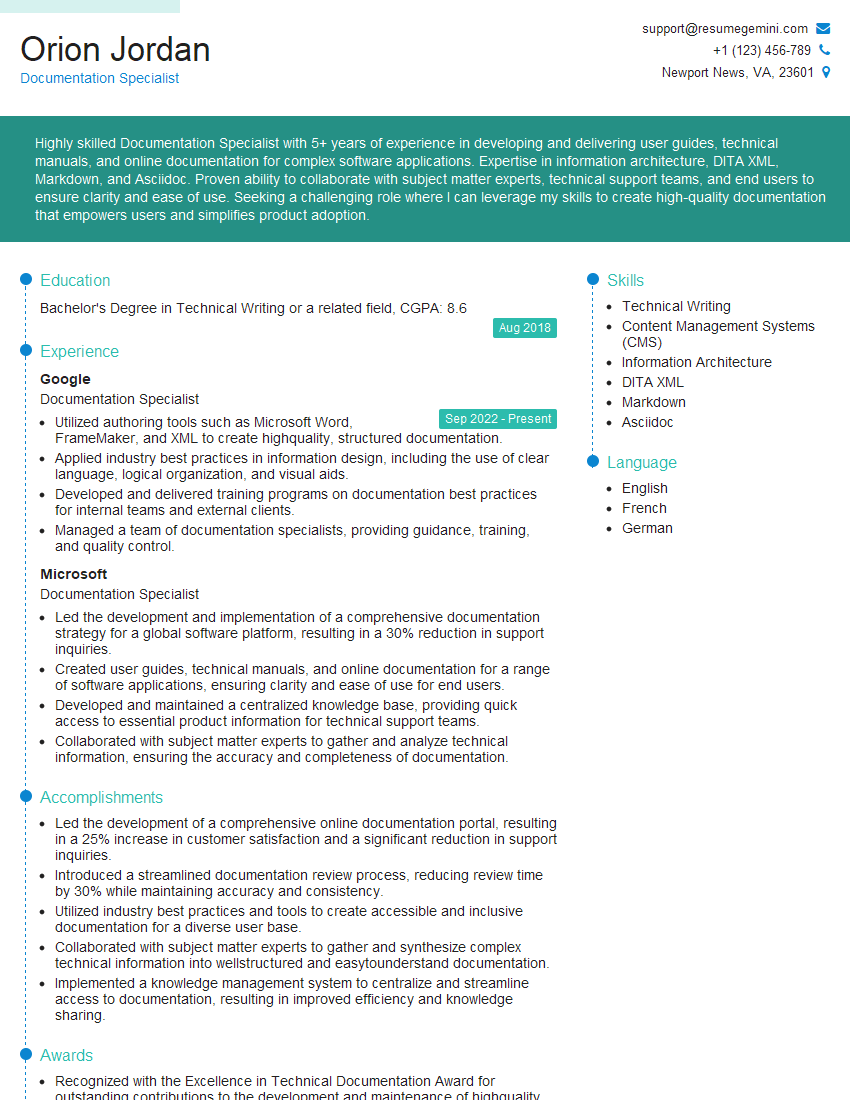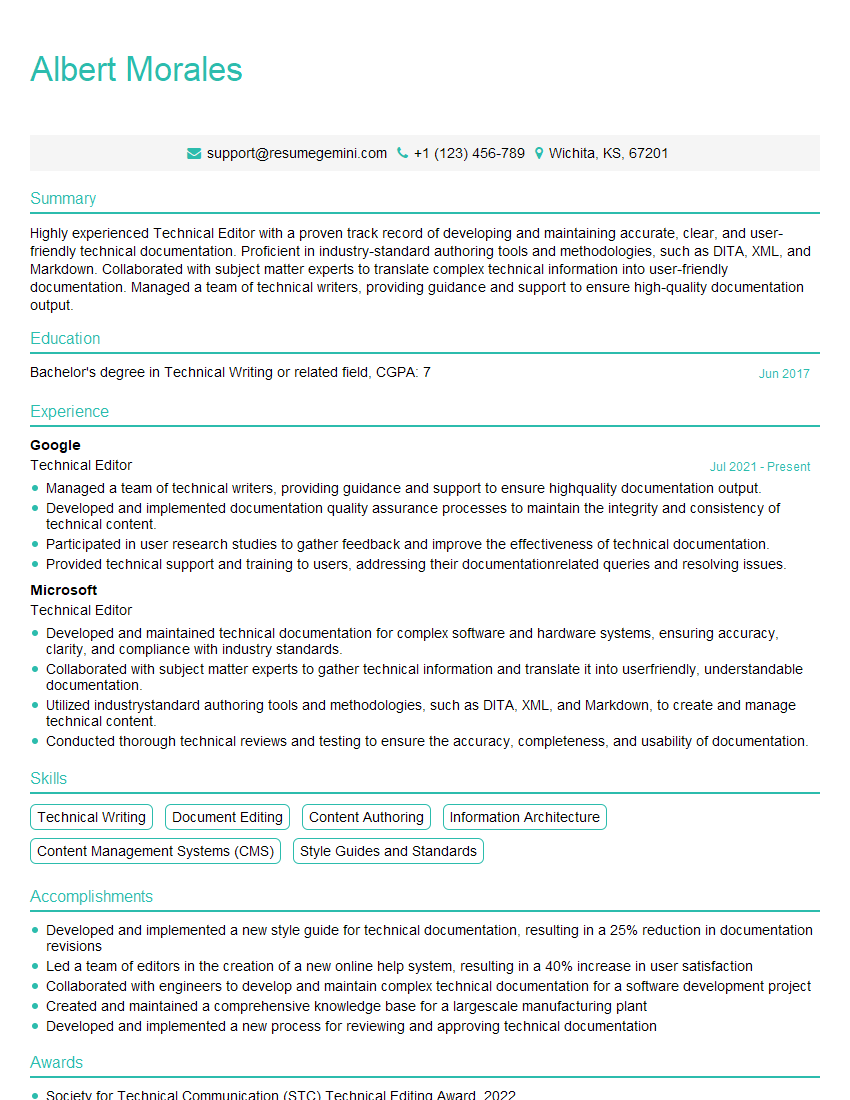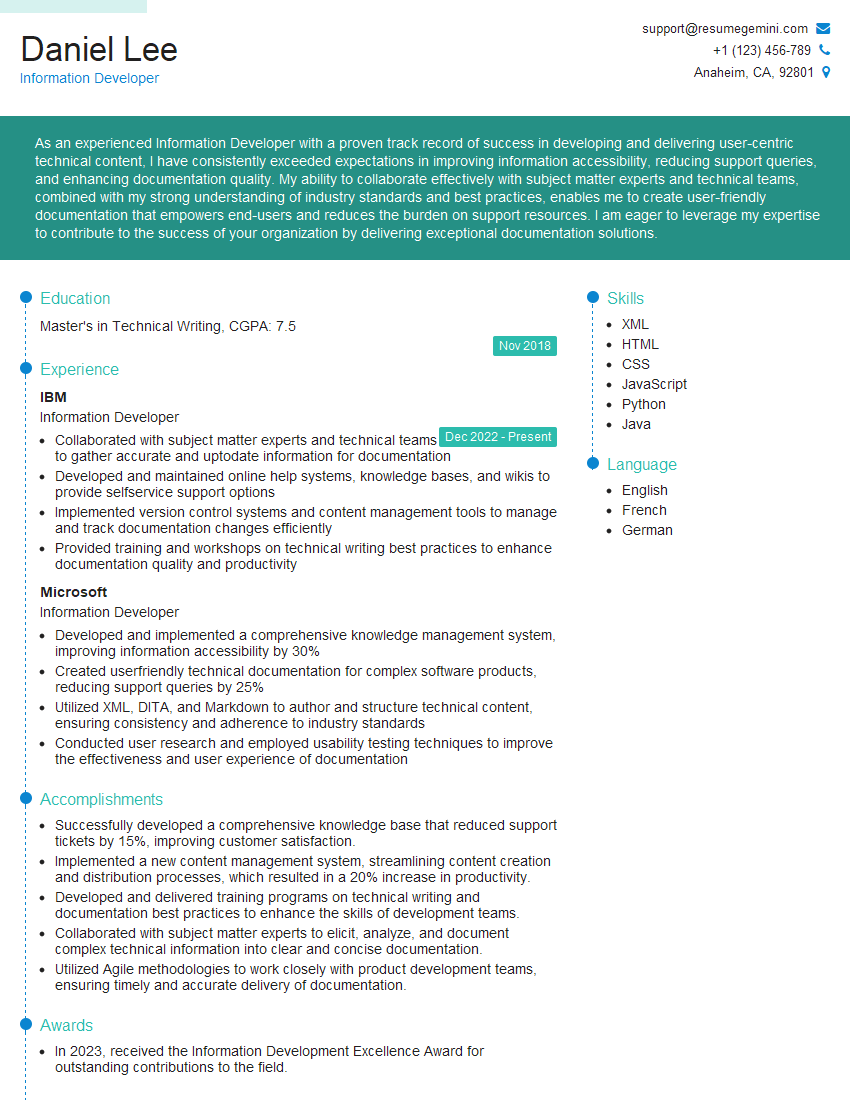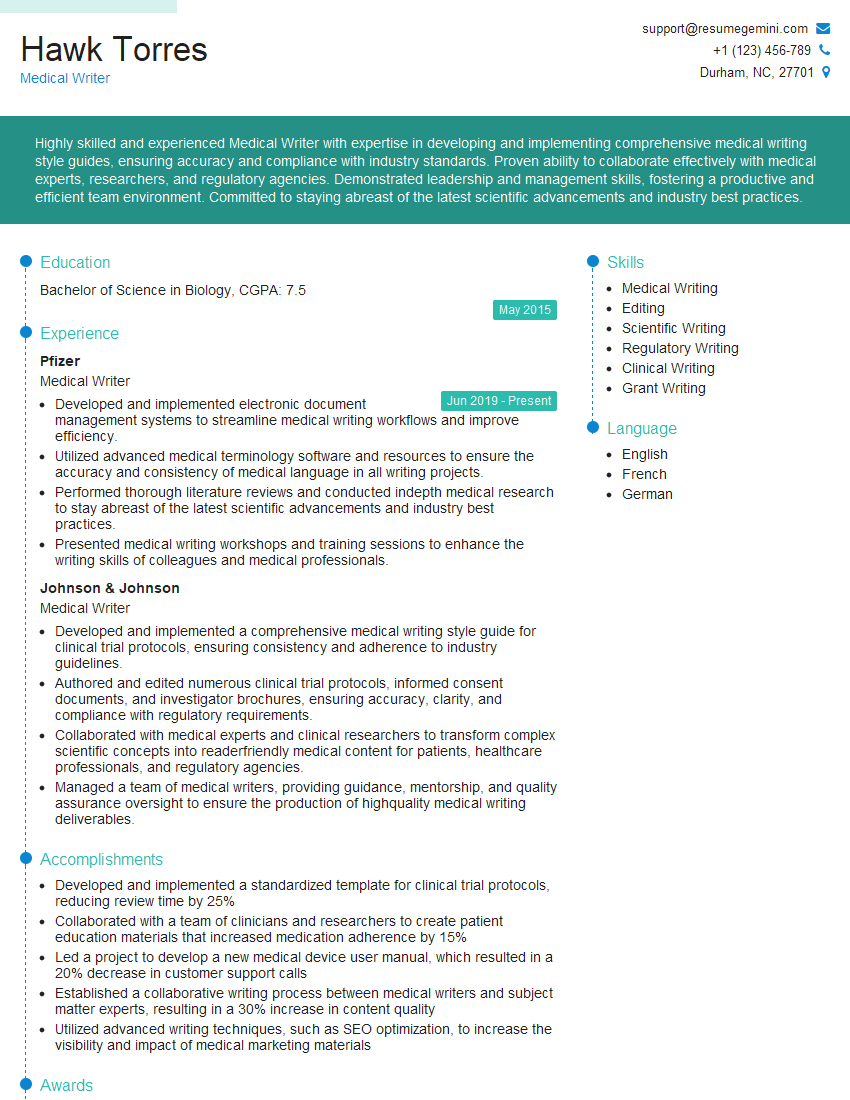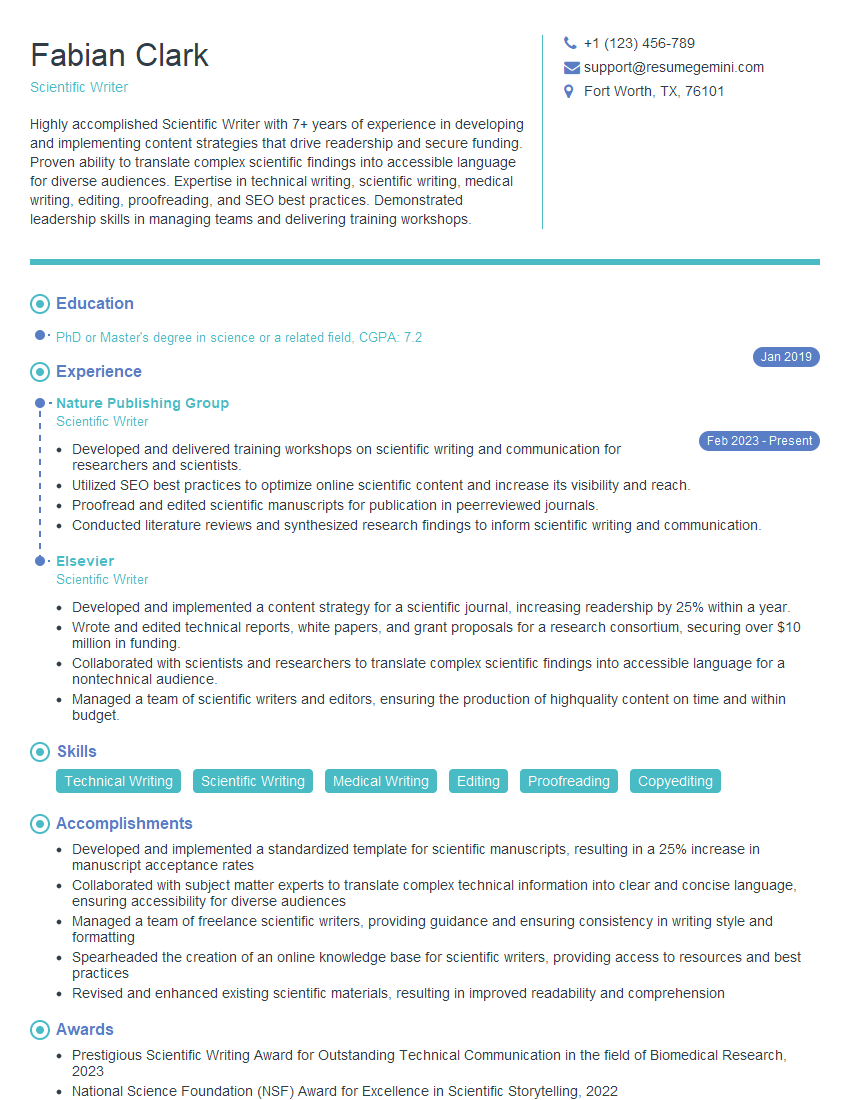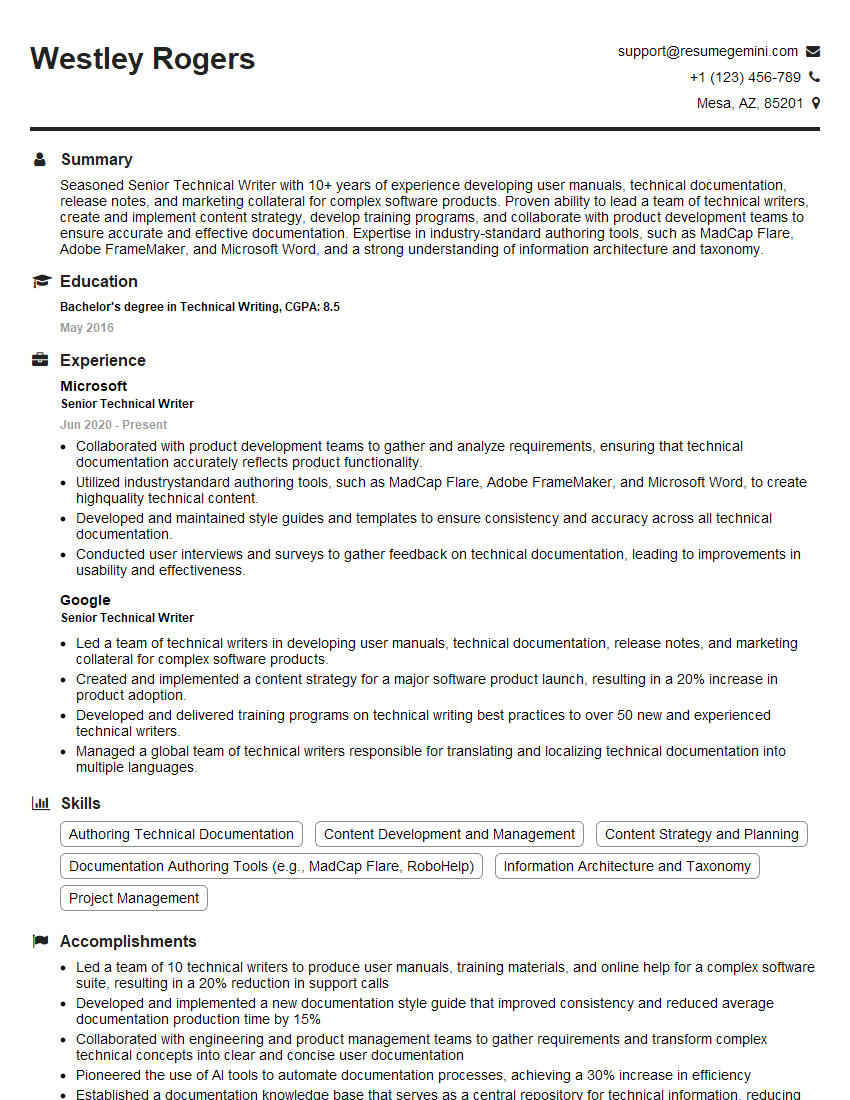Interviews are opportunities to demonstrate your expertise, and this guide is here to help you shine. Explore the essential Ethics in Technical Communication interview questions that employers frequently ask, paired with strategies for crafting responses that set you apart from the competition.
Questions Asked in Ethics in Technical Communication Interview
Q 1. Define ‘responsible disclosure’ in the context of technical documentation.
Responsible disclosure, in the context of technical documentation, means revealing potential vulnerabilities or risks in a product or system in a way that minimizes harm and maximizes benefit. It’s about ethically informing the appropriate parties – usually the developers or vendors – about the issue *before* publicly announcing it. This allows them time to fix the problem before malicious actors can exploit it.
Think of it like this: you find a security flaw in a piece of software. Instead of shouting it from the rooftops, responsible disclosure involves privately contacting the developers, providing detailed information about the vulnerability, and working with them to create a patch. Only after the patch is released and the vulnerability is addressed should you publicly discuss the issue.
The key elements of responsible disclosure are:
- Prioritizing security: The primary goal is to protect users from harm.
- Private communication: Initially, the disclosure should be kept confidential between the discoverer and the developers.
- Collaboration: Working with the developers to resolve the issue is crucial.
- Timely disclosure: After a reasonable timeframe for remediation, public disclosure might be warranted if the vendor isn’t cooperating.
Q 2. How do you ensure accessibility in technical communication for users with disabilities?
Ensuring accessibility in technical documentation means making it usable and understandable by everyone, including people with disabilities. This involves adhering to accessibility guidelines, such as WCAG (Web Content Accessibility Guidelines), and incorporating various strategies into the writing and design process.
Here are some key strategies:
- Using clear and simple language: Avoid jargon and complex sentence structures.
- Providing alternative text for images: Use the
altattribute in HTML to describe images for screen readers. - Using appropriate heading levels: Use
<h1>to<h6>tags to structure the document logically, making it easier for screen readers to navigate. - Ensuring sufficient color contrast: Use enough contrast between text and background colors to make the text readable.
- Providing captions and transcripts for videos and audio: This ensures that the content is accessible to users who are deaf or hard of hearing.
- Using structured data: Use schema.org markup to improve searchability and accessibility for assistive technologies.
- Offering multiple formats: Provide the documentation in different formats (e.g., PDF, HTML, audio) to cater to different user needs.
For example, instead of writing ‘The widget’s functionality is contingent upon successful API integration,’ we should say, ‘The widget works only if it’s properly connected to the API.’
Q 3. Explain the ethical implications of using AI in generating technical documentation.
The ethical implications of using AI in generating technical documentation are multifaceted. While AI can automate tasks like creating basic documentation and translating text, we must carefully consider several ethical concerns:
- Bias and fairness: AI models are trained on data, and if that data reflects existing biases, the generated documentation may also be biased. For instance, if the training data primarily focuses on a certain user demographic, the generated documentation might not be inclusive of others.
- Accuracy and reliability: AI-generated text should be rigorously reviewed and fact-checked to ensure accuracy. AI can sometimes hallucinate information, creating inaccurate or misleading documentation.
- Transparency and accountability: It’s crucial to be transparent about the use of AI in creating the documentation. Users should know that they are interacting with AI-generated content and not just human-written text. Accountability for errors or inaccuracies needs to be clear.
- Job displacement: The automation potential of AI in technical writing raises concerns about job displacement for technical writers.
- Copyright and intellectual property: The ownership and copyright of AI-generated content can be complex and needs careful consideration.
Ethical AI usage requires careful human oversight, bias mitigation strategies, and a commitment to transparency.
Q 4. Describe a situation where you had to balance clarity with potential user misinterpretation in your writing.
I once wrote documentation for a complex software feature that involved several interconnected settings. While I strived for clarity, I realised a particular phrasing could be easily misinterpreted by less technically savvy users, potentially leading them to configure the system incorrectly.
The initial phrasing was: ‘To enable advanced features, set both the ‘primary’ and ‘secondary’ flags to ‘active’. However, users could misinterpret ‘active’ and assume that setting one flag to ‘active’ would be sufficient. This could lead to the system behaving unexpectedly.
To address this, I revised the phrasing to: ‘To enable advanced features, you must set *both* the ‘primary’ and ‘secondary’ flags to ‘active’. If only one flag is set to ‘active’, the advanced features will not work.’ This added emphasis and explicitly highlighted the need for both flags to be configured correctly, minimizing the potential for misinterpretation.
Q 5. How do you handle conflicting priorities between user needs and corporate interests in your documentation?
Balancing user needs and corporate interests is a constant challenge in technical communication. Sometimes, what’s best for the user might not align perfectly with the company’s marketing goals or release deadlines.
My approach involves:
- Open communication: I actively communicate with stakeholders from both user experience and business sides to understand their priorities and find common ground.
- Prioritizing user safety and understanding: While business goals are important, I always prioritize accurate, clear, and safe documentation for users. If there’s a conflict, I advocate for the user’s needs, presenting well-reasoned arguments.
- Creative problem-solving: I seek ways to meet both user needs and business objectives. For instance, I might suggest alternative phrasing or present information strategically to balance transparency and marketing considerations.
- Documenting decision-making processes: I maintain a clear record of decisions made, explaining the reasoning behind them, to facilitate future discussions and ensure accountability.
The key is to find a balance – not compromise the safety or understanding of the users while still adhering to the company’s goals to the greatest extent possible.
Q 6. What are the ethical considerations of omitting or downplaying potentially negative information in technical documentation?
Omitting or downplaying potentially negative information in technical documentation is ethically problematic. It constitutes a form of deception and can lead to user harm. Users rely on documentation to make informed decisions, and withholding crucial information, even if it’s negative, violates the trust that underlies the writer-user relationship.
For instance, failing to mention safety precautions in a product manual, or downplaying the risks of a certain feature, can have severe consequences. Ethical considerations demand full transparency about potential drawbacks, limitations, or risks. This includes clearly communicating:
- Potential hazards or risks: Detailed warnings and safety instructions.
- System limitations: Clearly stating what the system *cannot* do.
- Known bugs or issues: Disclosing any known defects and their workarounds.
- Data privacy concerns: Explicitly addressing how user data is handled and protected.
It’s better to be upfront and transparent, even if it means presenting negative information. This builds user trust and ultimately protects users from potential harm.
Q 7. How do you ensure accuracy and avoid bias in your technical writing?
Ensuring accuracy and avoiding bias in technical writing requires a multi-pronged approach. It’s not just about getting the facts right; it’s about presenting them fairly and without prejudice.
Here are some strategies:
- Verifying information from multiple reliable sources: Don’t rely on a single source for information. Cross-reference data to ensure consistency and accuracy.
- Using precise and unambiguous language: Avoid vague terminology or language that could be interpreted differently by different readers.
- Fact-checking all claims: Every assertion in the documentation should be checked for accuracy.
- Seeking feedback from diverse reviewers: Get feedback from individuals with varied backgrounds and perspectives to identify any potential biases in the content.
- Being mindful of language and tone: Avoid language that is discriminatory, offensive, or perpetuates stereotypes. Strive for neutral and inclusive language.
- Using data visualization responsibly: Charts and graphs should be created accurately and not manipulated to present a biased view.
For instance, using gender-neutral pronouns and avoiding ethnocentric language are simple yet powerful ways to avoid bias. Continuous self-reflection and a commitment to fairness are key to producing ethical and unbiased technical documentation.
Q 8. Explain how you would address the ethical concerns of using proprietary information in your documentation.
Addressing ethical concerns around proprietary information in documentation hinges on a clear understanding of confidentiality agreements and intellectual property rights. My approach involves three key steps:
- Identifying Sensitive Information: I meticulously review all material for any data marked as confidential, trade secrets, or subject to non-disclosure agreements (NDAs). This includes specifications, algorithms, internal processes, and client-specific details.
- Seeking Clarification and Permission: If I’m unsure about the classification of specific information, I proactively seek clarification from the relevant stakeholders (managers, legal, clients). I’d never publish anything without explicit written permission.
- Applying Appropriate Security Measures: Depending on the sensitivity, I’d employ various security measures like access controls, anonymization, or aggregation of data. For instance, instead of detailing a precise algorithm, I might describe its functionality at a high level.
For example, if working on documentation for a new software feature with a patented algorithm, I’d ensure that the documentation explains the feature’s function and user interaction without revealing the specific patented elements. Instead of sharing the code, I’d focus on user experience and results.
Q 9. Discuss your approach to maintaining data privacy and security in technical communication.
Data privacy and security are paramount in technical communication. My approach is multifaceted:
- Compliance with Regulations: I prioritize understanding and adhering to relevant regulations like GDPR, CCPA, and HIPAA, depending on the project and its data.
- Data Minimization: I only include the data absolutely necessary for the documentation’s purpose. Unnecessary information increases the risk of a breach.
- Secure Data Handling: I use secure storage and transmission methods for all sensitive data, including utilizing encrypted drives, password-protected files, and secure collaboration platforms.
- Access Control: I follow strict access control protocols, ensuring only authorized personnel have access to sensitive documentation and data.
- Regular Security Updates: I regularly update my software and systems to mitigate vulnerabilities and stay abreast of the latest security threats.
For example, when dealing with user data in a help document, I would avoid including personally identifiable information (PII) like names, addresses, or specific account details. Instead, I’d use anonymized data or hypothetical scenarios to illustrate my points.
Q 10. How do you navigate intellectual property rights when creating technical documentation?
Navigating intellectual property (IP) rights requires careful attention to detail and a proactive approach. My strategy involves:
- Identifying IP Rights: I carefully identify all forms of IP embedded in the project, including trademarks, copyrights, patents, and trade secrets.
- Obtaining Permissions: I ensure I have the necessary permissions to use any copyrighted material or intellectual property. This includes obtaining licenses or permissions from copyright holders and citing sources appropriately.
- Attribution and Citation: I meticulously cite all sources using a consistent citation style (like APA or MLA) to avoid any accusations of plagiarism or copyright infringement.
- Understanding Open Source Licenses: When working with open-source components, I understand and comply with the associated licenses (e.g., GPL, MIT).
For example, if I’m using a third-party library in a software project, I’d carefully review its license to ensure I can legally use and document it in my technical documentation. I’d then include the appropriate attribution in the document.
Q 11. Describe a situation where you had to deal with a potentially unethical request from your manager or client.
In a previous role, my manager requested that I omit a crucial safety warning from a product manual to avoid delaying the product launch. I understood the pressure to meet deadlines, but omitting a safety warning was ethically unacceptable and potentially harmful to users.
My approach was to:
- Document the request in writing: I emailed the manager detailing the request, my concerns, and the potential consequences.
- Present alternatives: I suggested alternative solutions like a revised launch date or a shortened, less detailed safety warning, but one that still contained the critical information.
- Escalate the issue if needed: When my concerns weren’t addressed, I escalated the issue to the relevant ethics committee within the company.
Ultimately, the company chose to revise the launch date to include the full safety warning. This outcome reinforced my commitment to ethical decision-making even when facing pressure. Prioritizing user safety over short-term gains was crucial.
Q 12. How do you ensure compliance with relevant regulations (e.g., GDPR, HIPAA) in your work?
Ensuring compliance with regulations like GDPR, HIPAA, and others involves several steps:
- Thorough understanding of the regulations: I dedicate time to thoroughly understanding the requirements of each relevant regulation. This often involves reviewing guidelines and seeking legal counsel when needed.
- Data Mapping and Privacy Impact Assessments: For projects involving personal data, I conduct data mapping exercises to identify all data points and perform privacy impact assessments to analyze potential risks.
- Data Minimization and Anonymization: I employ techniques to minimize the collection and retention of personal data, and anonymize data where feasible.
- Compliance training: I actively participate in compliance training programs provided by my employer.
- Collaboration with legal and compliance teams: I work closely with the legal and compliance teams to ensure all documentation complies with the regulations.
For example, when documenting a healthcare application subject to HIPAA, I would focus on describing the application’s functionality without disclosing protected health information (PHI).
Q 13. What strategies do you use to avoid plagiarism in your technical writing?
Avoiding plagiarism in technical writing is crucial for maintaining professional integrity. My strategies include:
- Careful note-taking and source tracking: I meticulously document all sources used, recording details like URLs, author names, publication dates, and page numbers.
- Paraphrasing and summarizing: I avoid direct copying by paraphrasing information in my own words and summarizing key concepts. I ensure that I retain the original meaning while using my own writing style.
- Proper citation and referencing: I consistently use a standardized citation style (e.g., APA, MLA, Chicago) to give credit to all sources.
- Using plagiarism detection tools: I utilize plagiarism detection software as an additional check to ensure originality.
- Ethical use of quotes: When direct quotes are necessary, I enclose them in quotation marks and cite the source accurately.
Think of it like building with LEGOs – you can use existing blocks (information from sources), but you need to assemble them in your own creative way, clearly showing where you obtained each block (through proper citations).
Q 14. How would you respond to a user discovering an error in your documentation?
Discovering an error in documentation is an opportunity to demonstrate professionalism and commitment to accuracy. My response would involve:
- Acknowledge the error immediately: I promptly acknowledge the error and thank the user for bringing it to my attention. This shows respect for their time and input.
- Investigate the error: I thoroughly investigate the error to understand its cause and impact. This could involve testing, reviewing source material, or consulting colleagues.
- Correct the error and document the fix: I correct the error and document the fix, including a version history or changelog.
- Communicate the fix to users: I communicate the correction to the affected users, perhaps through an updated document, a notification, or a forum post.
- Learn from the error: I analyze the cause of the error to identify potential improvements in my documentation process or workflow.
Open communication and prompt action are key to building trust and maintaining credibility with users. Addressing errors transparently shows a commitment to accuracy and continuous improvement.
Q 15. How do you contribute to a culture of ethical practices in your team?
Building a culture of ethical practices in my team starts with leading by example. I consistently demonstrate ethical behavior in my own work, from accurately representing data to respecting deadlines and intellectual property. Beyond personal conduct, I actively foster open communication where ethical dilemmas can be discussed without fear of retribution. This includes establishing clear guidelines based on established codes of ethics in technical communication, like those offered by the Society for Technical Communication (STC). We regularly review these guidelines during team meetings, brainstorming potential ethical challenges we might face and discussing best practices. I also actively encourage team members to report any concerns, providing support and guidance as needed. For instance, if a team member notices inaccurate information in a document, I encourage them to raise it, and we collaboratively address it. This creates a safe and supportive environment where ethics are prioritized.
- Regular Ethics Training: Implementing regular training sessions on ethical considerations within technical communication.
- Open Dialogue: Fostering a culture of open dialogue where ethical concerns can be freely discussed.
- Clear Guidelines: Establishing and communicating clear ethical guidelines.
Career Expert Tips:
- Ace those interviews! Prepare effectively by reviewing the Top 50 Most Common Interview Questions on ResumeGemini.
- Navigate your job search with confidence! Explore a wide range of Career Tips on ResumeGemini. Learn about common challenges and recommendations to overcome them.
- Craft the perfect resume! Master the Art of Resume Writing with ResumeGemini’s guide. Showcase your unique qualifications and achievements effectively.
- Don’t miss out on holiday savings! Build your dream resume with ResumeGemini’s ATS optimized templates.
Q 16. Explain your understanding of the ethical implications of using persuasive language in technical documentation.
Persuasive language in technical documentation walks a fine line. While it’s crucial to make documentation clear and engaging, employing manipulative language to sway readers toward a specific conclusion, without providing a balanced perspective or full disclosure, is unethical. For instance, exaggerating product features or downplaying potential risks to drive sales is deceptive. Ethical use of persuasive language focuses on clarity and user understanding. It should highlight benefits accurately, and not mislead the reader. This includes using strong verbs and active voice to improve clarity, but not using emotionally charged language to manipulate decision-making. We must ensure that all information presented is accurate, complete, and avoids hidden agendas or biased interpretations.
Consider the example of a software manual. Ethical persuasion would highlight the software’s ease of use and efficient features with factual evidence, while unethical persuasion might exaggerate its capabilities or fail to mention significant limitations. It’s all about responsible communication, transparency, and avoiding the exploitation of the reader’s trust.
Q 17. What is your process for reviewing and revising your work for ethical considerations?
My review process involves a multi-step approach to ensure ethical considerations are thoroughly addressed. Firstly, I conduct a self-review focusing on factual accuracy, objectivity, and avoidance of bias. This includes checking for potential conflicts of interest and ensuring all claims are supported by evidence. Secondly, I use a peer-review system where another team member reviews my work for potential ethical oversights. This provides a fresh perspective and helps identify any areas I might have missed. Finally, I conduct a final review, incorporating feedback from both the self-review and peer-review stages. This involves cross-checking information against multiple sources to confirm accuracy, checking for any potentially misleading language, and ensuring the overall tone is responsible and objective. This layered approach provides a robust ethical safeguard.
Q 18. How do you incorporate user feedback to improve the ethical aspects of your documentation?
User feedback is invaluable in improving the ethical aspects of my documentation. I actively solicit feedback through various channels, such as surveys, usability testing, and direct communication. This feedback helps identify any areas where the documentation might be misleading, difficult to understand, or unintentionally biased. For example, if users repeatedly misunderstand a particular section, it suggests a need for clearer explanations or a different approach. Analyzing this feedback helps me refine my writing to better meet users’ needs and avoid any potential ethical pitfalls. Regularly incorporating this feedback in iterative design ensures the documentation remains clear, accessible, and ethically sound.
Q 19. How do you handle situations where you disagree with a client or manager’s ethical decisions regarding the documentation?
Disagreements on ethical decisions are challenging, but addressing them ethically is crucial. My approach involves clearly articulating my concerns, based on ethical guidelines and best practices within the technical communication field. I attempt to explain the potential consequences of the proposed approach and suggest alternative solutions. I present evidence-based arguments, emphasizing the importance of accuracy, transparency, and user safety. If the disagreement persists, I would document my concerns thoroughly and, if necessary, escalate the issue to higher management, highlighting potential legal or reputational risks. Ultimately, my commitment is to ethical practices, even if it means respectfully dissenting from a client or manager’s decision. Maintaining my professional integrity is paramount.
Q 20. Describe your understanding of environmental, social, and governance (ESG) considerations in technical communication.
Environmental, Social, and Governance (ESG) considerations are increasingly important in technical communication. ESG factors encompass the environmental impact of the product or service being documented, the social implications of its use, and the governance structures related to its development and deployment. In my work, this translates into: carefully considering the environmental impact of a product and its lifecycle, ensuring the documentation clearly and accurately addresses potential environmental consequences. It also involves being mindful of the social impact, such as accessibility for users with disabilities or the potential for misuse of the technology. Finally, it means ensuring that the development and deployment of the technology are governed ethically and transparently, respecting intellectual property, and ensuring data privacy.
For example, if I’m documenting software for energy management, I would ensure the documentation clearly communicates its energy-saving capabilities and its overall environmental footprint. If I’m documenting a social media platform, I would focus on its potential impact on user well-being and its methods for data protection.
Q 21. How do you ensure transparency and accountability in your technical writing practices?
Transparency and accountability are fundamental to ethical technical writing. I ensure transparency by clearly identifying my sources, acknowledging any limitations of the information presented, and avoiding any misleading or deceptive language. I maintain detailed records of my work, including revisions and feedback, to ensure accountability. This documentation is crucial for tracking changes and addressing any potential errors or concerns. Furthermore, I make myself available to answer questions about my work and proactively address any concerns or feedback received. This open communication fosters trust and accountability, which are essential for maintaining ethical standards in technical communication.
Q 22. Explain how you would handle a situation where you find conflicting information from different sources.
Encountering conflicting information is a common challenge in technical communication. My approach involves a systematic investigation to establish the most accurate and reliable source. First, I’d evaluate the credibility of each source, considering the author’s expertise, potential biases, the publication date, and the overall reputation of the source. For instance, a peer-reviewed journal article carries more weight than an anonymous blog post.
Second, I would cross-reference the information with other credible sources to identify any patterns or inconsistencies. If the discrepancy persists, I’d attempt to contact the authors of the conflicting sources to clarify the information. Finally, if reconciliation isn’t possible, I’d clearly state the conflicting information in my documentation, citing all sources and acknowledging the uncertainty. Transparency is crucial here; it’s better to acknowledge a knowledge gap than to present potentially misleading information as fact. This approach ensures ethical responsibility and builds trust with the audience.
Q 23. Discuss your experience with using open-source tools and resources while ensuring ethical compliance.
Open-source tools and resources are invaluable to technical communicators, but ethical compliance is paramount. My experience includes using open-source software like LaTeX for document creation and various online collaboration tools for version control and feedback. Ethical use involves adhering to the specific licenses associated with each resource. This usually includes properly attributing the source, respecting any restrictions on use or modification, and understanding whether the license permits commercial or non-commercial applications. For example, if I use a GPL-licensed tool in a commercial project, I am obligated to release the modifications I’ve made to that tool under the same license. Ignoring these licenses is not just unethical; it’s a legal violation.
I always carefully review the license before using any open-source tool. This is akin to reading the terms and conditions before downloading any software. It ensures I understand my responsibilities as a user and avoid any potential legal or ethical issues. I also actively contribute back to the open-source community when possible, providing feedback or fixing minor bugs— a crucial aspect of maintaining the ethical use and sustainability of these valuable resources.
Q 24. How do you balance the need for clear and concise communication with the need for complete and accurate information?
Balancing conciseness with completeness is a core skill in technical communication. It’s like finding the sweet spot between a recipe that’s too brief to follow and one that’s unnecessarily wordy. The key is to prioritize clarity and structure. I utilize techniques such as creating outlines, using headings and subheadings effectively, and employing visual aids like diagrams and tables to convey complex information efficiently.
For instance, I might use a concise table to summarize several related concepts, instead of describing them in lengthy paragraphs. However, brevity shouldn’t come at the cost of accuracy. I’ll thoroughly research my topic, ensure the information is verifiable, and always prioritize conveying all necessary information accurately. Omitting crucial information to maintain brevity would be unethical and potentially dangerous. It’s about making the information accessible, not simplifying it to the point of inaccuracy.
Q 25. How do you prioritize different ethical considerations when faced with multiple competing concerns?
Prioritizing competing ethical considerations requires a thoughtful and systematic approach. I often use a framework that combines ethical theories like utilitarianism (maximizing overall good) and deontology (adhering to moral duties). Imagine a scenario where I discover a security vulnerability in a product I’m documenting. On one hand, I have a duty to the company to protect its reputation (deontology), but on the other, I have a responsibility to warn users about a potential risk (utilitarianism).
My approach would involve carefully weighing these concerns. I’d first attempt to privately report the vulnerability to the appropriate team within the company. If the issue isn’t addressed adequately or timely, I might need to escalate it, potentially to higher authorities or even publicly disclose the vulnerability after responsible disclosure attempts have failed, always prioritizing user safety. This process ensures that I address the ethical dimensions of the situation in a balanced and responsible manner.
Q 26. Explain the importance of conducting user research to ensure ethical and inclusive documentation.
User research is fundamental to creating ethical and inclusive documentation. It’s not enough to assume we understand our audience; we must actively seek to understand their needs, perspectives, and capabilities. Through user interviews, surveys, and usability testing, we can gather data about how users interact with our product and documentation, identifying any potential barriers to understanding or accessibility.
For example, if our user research reveals that a significant portion of our audience has limited digital literacy, we would tailor our documentation accordingly, using simpler language, more visual aids, and a more intuitive structure. Ignoring the needs of specific user groups can lead to exclusion and inequitable access to information. User research helps ensure our documentation is accessible and usable by everyone, promoting inclusivity and ethical considerations in the information design and dissemination process.
Q 27. How do you address the potential for your technical documentation to be misused or misinterpreted?
Addressing the potential for misuse or misinterpretation of technical documentation is a significant responsibility. My approach is multi-faceted. First, I use clear, unambiguous language, avoiding jargon or technical terms that might be misunderstood by the intended audience. I carefully define any potentially ambiguous terms and provide examples to clarify meaning.
Second, I include prominent warnings and disclaimers where appropriate. If the documentation describes procedures that could be dangerous if performed incorrectly, I provide clear safety guidelines and warnings. Third, I anticipate potential misunderstandings. This involves thinking critically about how a user might misinterpret the documentation and proactively addressing those possibilities in the text itself. Finally, I ensure that the documentation is regularly reviewed and updated to reflect any changes in the product or any feedback received from users. These measures help minimize the risk of misuse and maximize the safe and responsible application of the information provided.
Key Topics to Learn for Ethics in Technical Communication Interview
- Audience Analysis and Responsibility: Understanding your audience’s needs, knowledge level, and potential biases, and crafting communication that is both accurate and accessible. Consider the ethical implications of simplifying complex information.
- Accuracy and Truthfulness: Maintaining the integrity of information presented; recognizing and addressing potential conflicts of interest; citing sources appropriately and avoiding plagiarism.
- Clarity and Transparency: Communicating technical information in a way that is easily understood by the intended audience, avoiding jargon where possible and proactively addressing potential misunderstandings.
- Confidentiality and Data Privacy: Understanding and adhering to relevant regulations and company policies regarding confidential information and protecting sensitive data.
- Intellectual Property Rights: Respecting copyright, patents, and trademarks; properly attributing work and avoiding unauthorized use of intellectual property.
- Environmental Responsibility: Considering the environmental impact of technological advancements and communicating responsibly about sustainability initiatives.
- Social Responsibility: Understanding and addressing the potential social and societal impacts of technologies and communicating these implications transparently.
- Professionalism and Integrity: Maintaining a high level of professional conduct, demonstrating integrity, and acting ethically in all communication endeavors.
- Case Studies and Ethical Dilemmas: Analyzing real-world examples of ethical challenges in technical communication and developing problem-solving strategies.
- Legal and Regulatory Compliance: Familiarizing yourself with relevant laws and regulations affecting technical communication, such as those related to advertising and marketing.
Next Steps
Mastering Ethics in Technical Communication is crucial for career advancement. It demonstrates your commitment to responsible and impactful communication, building trust with colleagues, clients, and the public. This is highly valued in today’s professional landscape. To further enhance your job prospects, create an ATS-friendly resume that highlights your ethical considerations and showcases your accomplishments effectively. We recommend using ResumeGemini, a trusted resource, to build a professional resume tailored to your skills and experience. Examples of resumes tailored to Ethics in Technical Communication are available to help you get started.
Explore more articles
Users Rating of Our Blogs
Share Your Experience
We value your feedback! Please rate our content and share your thoughts (optional).
What Readers Say About Our Blog
Dear Sir/Madam,
Do you want to become a vendor/supplier/service provider of Delta Air Lines, Inc.? We are looking for a reliable, innovative and fair partner for 2025/2026 series tender projects, tasks and contracts. Kindly indicate your interest by requesting a pre-qualification questionnaire. With this information, we will analyze whether you meet the minimum requirements to collaborate with us.
Best regards,
Carey Richardson
V.P. – Corporate Audit and Enterprise Risk Management
Delta Air Lines Inc
Group Procurement & Contracts Center
1030 Delta Boulevard,
Atlanta, GA 30354-1989
United States
+1(470) 982-2456



